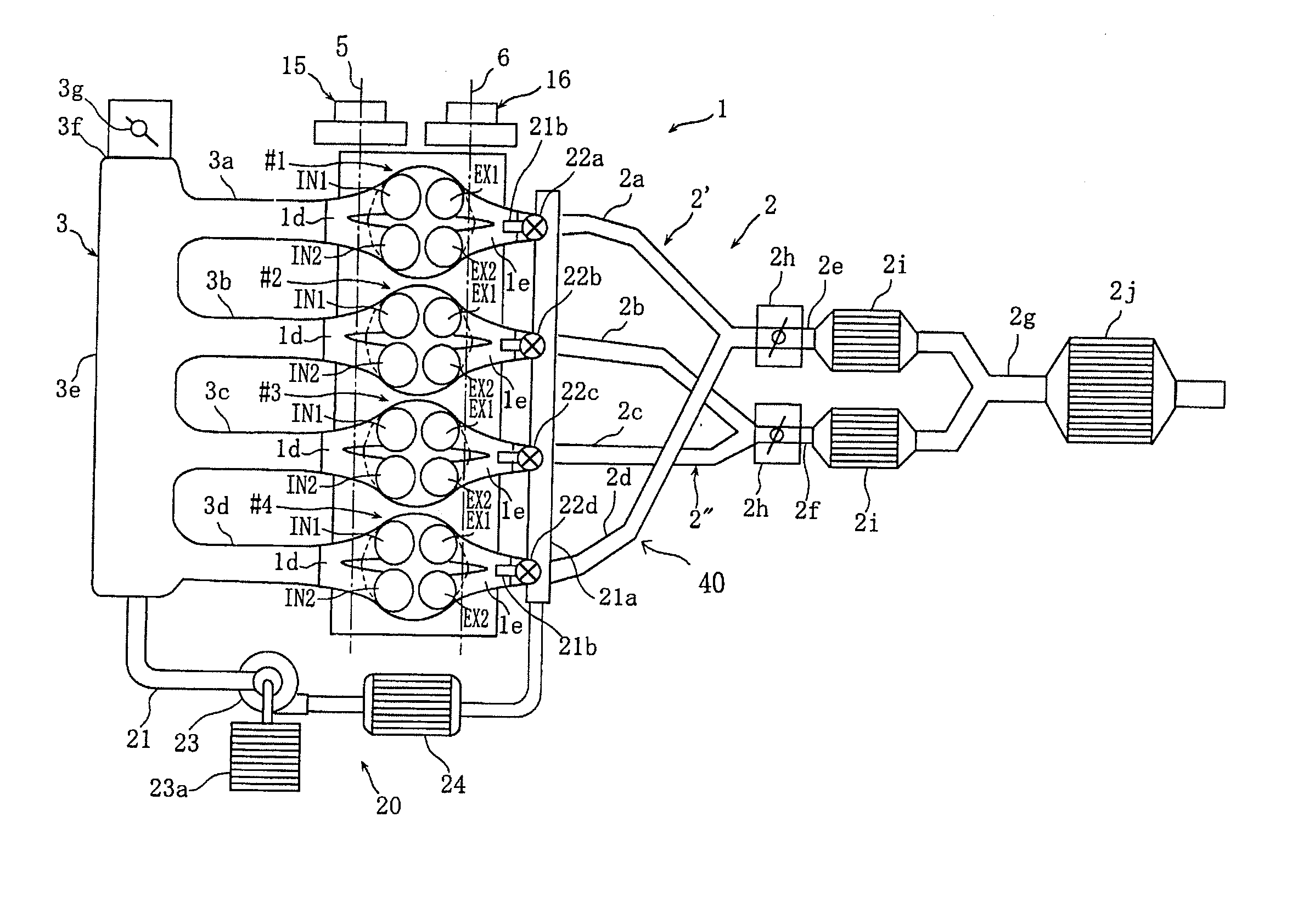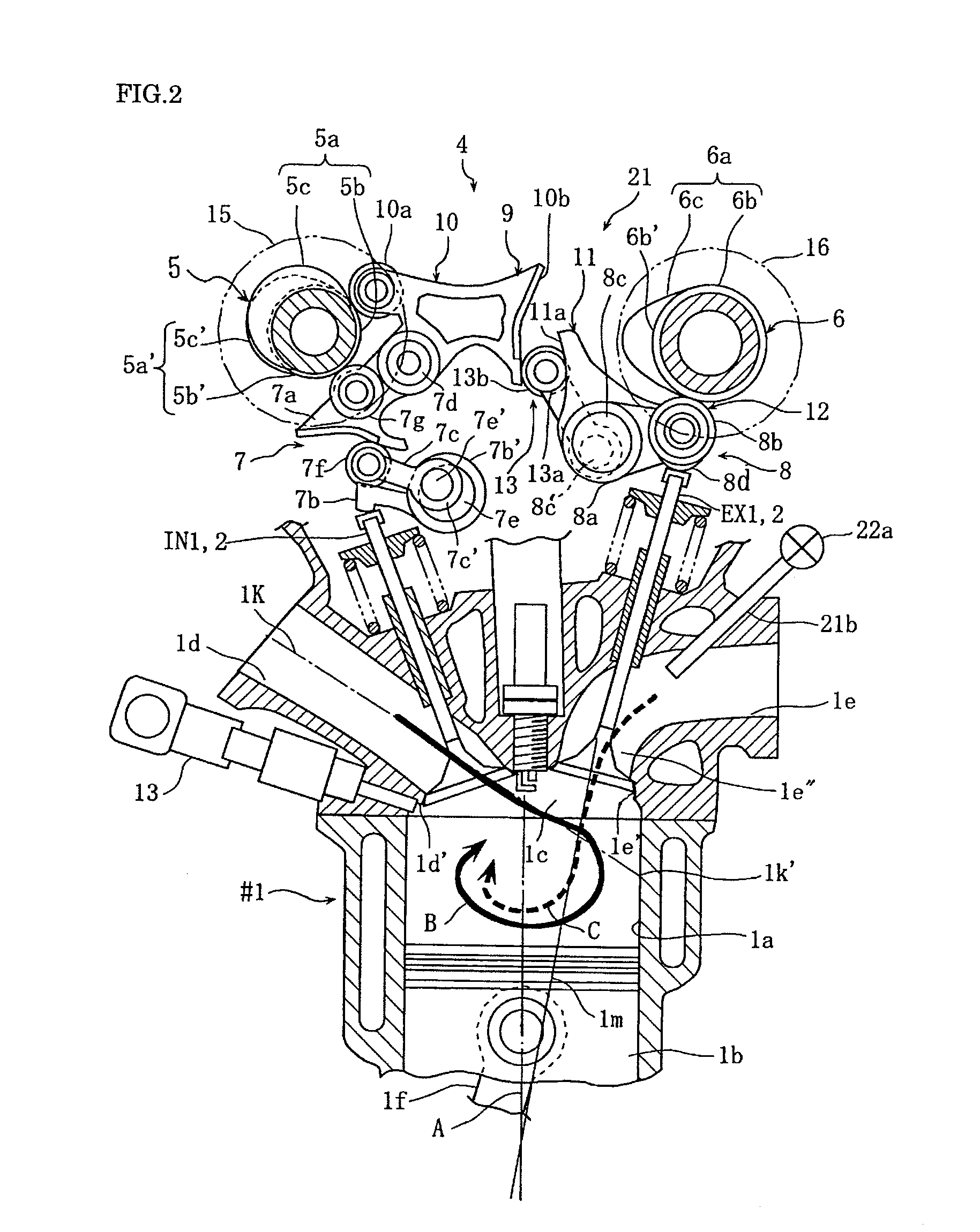Four-cycle engine
- Summary
- Abstract
- Description
- Claims
- Application Information
AI Technical Summary
Benefits of technology
Problems solved by technology
Method used
Image
Examples
first embodiment
[0049]FIG. 1 to FIG. 7 are views for describing a four-stroke engine according to the present invention. FIG. 1 is an overall structural view. FIG. 2 is a cross-sectional side view of this engine. FIG. 3 is a schematic plan view of a valve system. FIG. 4 are schematic views of a switching system. FIG. 5 to FIG. 7 are graphs for describing operations.
[0050]In the drawings, numeral 1 denotes an HCCI engine based on a four-cylinder, four-valve DOHC gasoline engine. This engine 1 includes #1 cylinder to #4 cylinder. The #1 cylinder to #4 cylinder each have four valves in total: two intake valves IN1, IN2 and two exhaust valves EX1, EX2. Further, the engine 1 includes in-cylinder gasoline injection valves 13, and has a compression ratio set to 12 which is optimal for spark ignition combustion.
[0051]The order of ignition in the engine 1 is #1-#3-#4-#2 cylinders. The phase between the cylinders (ignition interval) is 180 degrees in crankshaft angles. Therefore, the phase between the #1 cyl...
second embodiment
[0090]In middle of the air introduction path 30 connected to a surge tank 3e of an engine 1 of the second embodiment, a main supercharger 31 driven by an electric motor or engine output is interposed, so as to supply fresh air compressed at a predetermined pressure to the engine 1. In addition, numeral 30a denotes a bypass detouring the main supercharger 31, numeral 30b denotes a bypass valve which opens / closes the bypass 30a, numeral 32 denotes an intercooler which decreases the temperature of compressed fresh air, and numeral 33 denotes an air cleaner.
[0091]Compressed fresh air from the main supercharger 31 is introduced into the cylinder bore of the #1 cylinder from the intake port 1d by opening of the intake valves in an intake stroke of the #1 cylinder. Near the end of this intake stroke, there is an overlap period in which the intake valves are open and the exhaust valves are open by EGR valve opening. Moreover, also due to the introduced fresh air being in a compressed state,...
third embodiment
[0095]FIG. 10 to FIG. 13 are views for describing the present invention. In these views, the same reference numerals as in FIG. 1 and FIG. 8 denote the same or corresponding parts.
[0096]In an engine 1 of the third embodiment, a merging pipe 2e of a first exhaust system 2′ and a merging pipe 2g of a second exhaust system 2″ are connected to a turbocharger 36 having one common variable nozzle turbine. An intercooler 35 is interposed in an air path 34 connecting an air discharge port of the turbocharger 36 and a surge tank 3e. Further, a pressure sensor 2r is disposed on an exhaust branch pipe 2a.
[0097]Further, the engine 1 of the third embodiment has a secondary air supply system 20 having the same structure as that of the above-described first embodiment. This secondary air supply system 20 includes a secondary air supply path 21 connecting the surge tank 3e and the exhaust ports 1e, an auxiliary supercharger 23 and an intercooler 24 interposed in the secondary air supply path 21, a...
PUM
 Login to View More
Login to View More Abstract
Description
Claims
Application Information
 Login to View More
Login to View More - R&D
- Intellectual Property
- Life Sciences
- Materials
- Tech Scout
- Unparalleled Data Quality
- Higher Quality Content
- 60% Fewer Hallucinations
Browse by: Latest US Patents, China's latest patents, Technical Efficacy Thesaurus, Application Domain, Technology Topic, Popular Technical Reports.
© 2025 PatSnap. All rights reserved.Legal|Privacy policy|Modern Slavery Act Transparency Statement|Sitemap|About US| Contact US: help@patsnap.com



